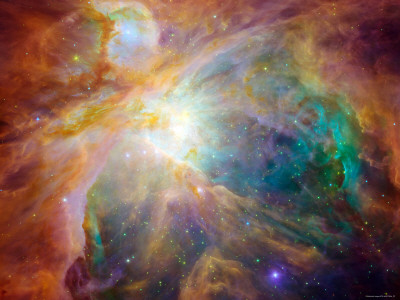A Brief Tour of Orion
The southern sky is dominated this month by the brightest constellation
in the heavens, Orion, the Hunter. The constellation is easy to
recognize because it contains several bright stars including a prominent
line of three bright stars that make up The Belt of Orion.
Above the belt is a bright reddish star called Betelgeuse that marks the
hunter's right shoulder. Betelgeuse (commonly pronounced "beetle juice")
is one of the largest stars known its diameter being much greater than
the Earth's orbit around the Sun! The distinct reddish color of
Betelgeuse contrasts with the bluish color of Rigel (left foot), a
blue-white supergiant star about 50 times larger than our Sun.
The color of a star is important to astronomers because it indicates the
temperature at the star's surface. Very hot stars (25 to 40,000°Celsius)
appear blue and relatively cool stars (3,000°C) appear red. Our Sun
appears yellow-white in color and has a surface temperature of 5,500°C.

Click Here for Information or to Buy this Print
Just below the Belt of Orion are three fainter stars that form The Sword
of Orion. The middle star is surrounded by the stunning Great Orion
Nebula (M42 on map). A look through even a small telescope reveals an
intricate glowing gas cloud that fills the view in any eyepiece. Within
the center of the Great Orion Nebula is a group of four hot young stars
known as the Trapezium which have formed from the gas in the nebula. The
Hubble Space Telescope has identified over 700 young stars at various
stages of formation in this stellar nursery including more than 150
protoplanetary disks that are believed to be embryonic solar systems
that will eventually form planets!
Elsewhere in the sky this month the planets Jupiter and Saturn remain
well placed for observation high in the western sky. The planet Mars,
although much fainter, is visible low in the west as an orange-colored
"star." Finally, morning observers will be rewarded with a series of
spectacular pairings of the crescent Moon with brilliant Venus in the
pre-dawn skies on February 2nd and 3rd.
Clear skies until next month!
Related Links:
Related Books:


